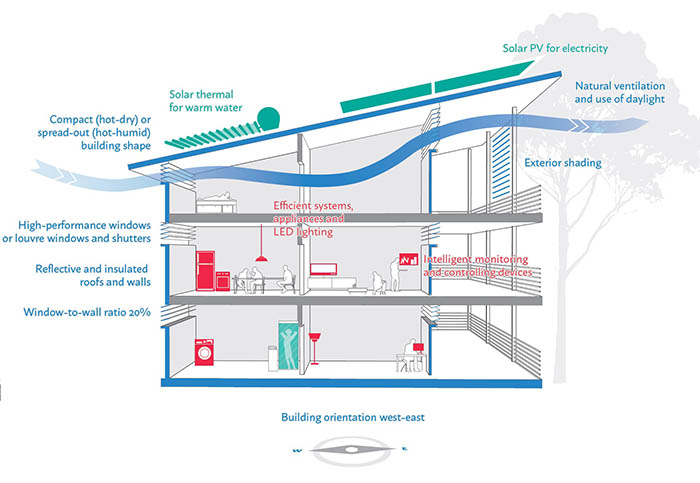Buildings and Construction: A sleeping giant for climate action
Today, the construction and operation of buildings is responsible for 40% of all energy-related carbon dioxide (CO2) emissions. Energy demand from this sector is expected to grow by another 50% by 2050.
This article originally appeared on IISD's SDG Knowledge Hub.
In the building sector, all trends are pointing upwards, with dramatic consequences for the climate. By 2060, the global building floor area is expected to double. Emerging and developing economies in warm and tropical climates will experience the biggest increase.
Already today, the construction and operation of buildings is responsible for 40% of all energy-related carbon dioxide (CO2) emissions. The sector consumes over a third of global final energy. Energy demand from the building sector is expected to grow by another 50% by 2050. Space cooling is a key driver of this demand – energy needs for space cooling are expected to triple.
Buildings cause greenhouse gas (GHG) emissions both when they are built, and over their long lifetime of 30 to 80 years. Our modern way of constructing is mostly based on concrete, using standard blueprints regardless of the climate. This leads to high energy bills for those who can afford it, and economic and health risks for those who cannot.
Future-proofing Buildings Can Drive SDGs 1, 7, 11
Energy-efficient buildings are not rocket science. Improvements in the building’s outer structure and appliances can achieve substantial energy savings compared to standard buildings. Measures to future-proof buildings can range from “low-tech,” such as painting roofs in light colors and ensuring natural shade, to digital solutions for building design and management. Additional macro-economic benefits include energy security, job creation and health. And from a business perspective future proofed buildings have a lower lifetime cost and higher asset values.

Climate action in buildings and construction is among the most cost-effective measures. The International Energy Agency (IEA) estimates that realizing the potential of sustainable buildings will save USD 1.1 trillion by 2050.
Nevertheless, this transition requires a shift in investment. USD 4.5 trillion are invested into real estate every year. To channel this investment towards energy efficiency, we need to influence it from two directions: ambitious policy and regulation serving as a “stick,” and financing as a “carrot.”
The Programme for Energy Efficiency in Buildings (PEEB), a French-German initiative, works with its first five partner countries – Mexico, Morocco, Senegal, Tunisia and Vietnam – to transform the building sector. PEEB combines financing energy efficiency in large-scale projects with technical assistance through policy advice. PEEB mobilizes innovative financing solutions for large building projects. For example, in Morocco PEEB supports the government in mobilising EUR 20 million in climate financing for a residential housing programme. A green loan programme for young families is in the making in Vietnam. The programme also works with partners to make policies and standards more ambitious and effective, through better enforcement of existing green building codes or setting standards for sectors like hotels or hospitals.
All of these advancements are helping to achieve 2030 Agenda targets on energy, housing and poverty.
Climate Action in the Building Sector is Gaining Momentum
Another international agreement – the Paris Agreement on climate change – also hangs in the balance; its goals will not be achieved without a climate focus for buildings in the new decade. A rapid decarbonization needs to happen in the building sector, driven by international and national actors.
In 2019, action on buildings took center stage. Led by the Global Alliance for Buildings and Construction (GlobalABC), buildings featured prominently at the climate change conference COP25 in Madrid, with topics ranging from zero carbon buildings to circular economy approaches in the buildings sector. The Global Status Report on Buildings and Construction confirmed the urgent need for action in the building sector. At the Climate Action Summit convened by the United Nations in September 2019, the Net Zero Carbon initiative was launched to leverage the leadership of governments, industry and civil society to commit to ambitious targets and mobilize funding. The Cool Coalition and SEforALL’s Cooling for All initiative have incorporated buildings as a key element of their strategies.
As we head into 2020, buildings are high on the agenda. The World Economic Forum has named moving towards zero carbon buildings as one of its four top priorities for tackling climate change. The report by the UK government on energy transitions features buildings as a key sector. The lead-up to the Glasgow Climate Change Conference (UNFCCC COP 26) in 2020 has an unprecedented opportunity to raise the ambition of all actors to make our buildings future-proof and wake this sleeping giant.
The author of this guest article, Christiana Hageneder, is the Head of Secretariat, Programme for Energy Efficiency in Buildings (PEEB).
You might also be interested in
The Indonesia Cooking Diaries Study
This study evaluates the feasibility and implications of switching from cooking with LPG to induction stoves in Indonesian households.
How South Africa can Improve Grid Battery Deployment to Unlock Economic and Security Benefits
South Africa can take action to boost the deployment of grid-located batteries through better understanding of the sector, co-operative planning, increasing access to finance, and supporting localized production, new research suggests.
Watts in Store Part 2
Creating an enabling environment for grid battery deployment in South Africa while maximizing key benefits and minimizing social and environmental risks.
Pragmatically Integrating Sustainability Into the Reconstruction of Ukraine
IISD's brief investigates the pragmatic implementation of sustainability measures for rebuilding Ukrainian cities and looks into tangible solutions ready to be implemented during and after the war.
